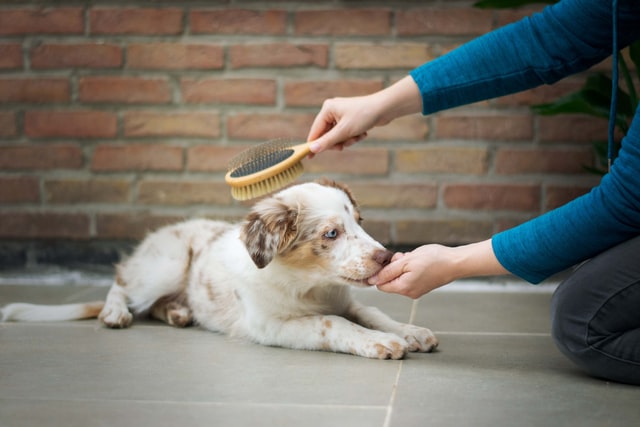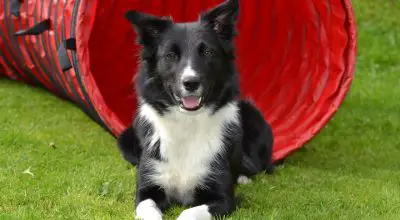There is no other breed like the Border Collie. The combination of a brilliant color pattern to a highly intelligent and devoted dog results in an amazing furry creature. Knowing the facts regarding the red merle Border Collie will allow you to see its uniqueness from the typical BC.
What is a Merle?
Merle is a dispersion of the body’s natural color with darker stripes or smudges. It usually happens on black or red colored BC.
If there is the least typical pattern of the Border Collie, it is none other than the merle shade. There will be a light gray or blue merle variation if the dog is predominantly black. While, it gives a pale red variation if it is predominantly red.
It is worth noting that the merle pattern only appears on the body’s colored area and not on its white markings. The term “merle” or “merling” is sometimes a description of the extreme flaking or mottling in the dog’s skin within the white marks. However, these designs are not authentic merles.
Merle refers to an epistatic gene that affects more than only its own biological partner but also other color genes.
Regardless of the dog’s underlying color genes, the merle pattern will create dilution and splotching unless the puppy is entirely white. Initially, merle appears to be the dominant one.
Merle is the result from parent dogs with merle allele. Since the merle is only partially dominant, it is, however, unique. Purebred merles also have a unique color pattern which comes from dogs having two merle alleles.
How to Have a Red Merle Border Collie?
The dilution of coat tone is an end product of the M gene domination that generally affects eumelanin. Blue merle gives off a black shade in this process, while the red merle comes from brown color. Under homozygosis, a white-merle type specimen which is devoid of all coloring comes out from the dominant gene (MM).

The dominance of the Mm gene resulted into the non-white markings on the red merle Border Collie contains a brown foundation that are still a merle. However, the red merle color is relatively uncommon even if there is also an existence of the recessive bb allele in the chocolate/liver color.
Aside from the merle pattern, there is also the occurrence of the dominant allele of the A genotype. Having that, it results in a tri-color red merle. The manifestation of this uneven color dilution is a white base with patterns of black and red. The most frequent color in this instance is the red shade.
Compared to the red merle type, brown shade is more prevalent along with portions of black markings on the tri-color red merle Border Collie. Up until you notice the darker third hue, they can appear to be pretty identical.
Double Merle
The “double-merle” dog has some merle-colored markings here and there but is primarily white. Although this is quite fine, the double merle dog is more likely to experience major health issues.
Double merle creation can only be done by jointly pairing two merles together. This cross breeding produces pups that are simple merles in half of the litter, yet the other will be double merles, and the remaining other will be solid colored.
Collies and Shelties both have a fair amount of the merle gene. In these breeds, the production of the double merles is sometimes intentional because of the requirements of “beautiful” color for show rings.
Despite any individual issues, the merle puppies will come out from a double merle giving it an excellent importance as a breeding dog. Purposeful breeding of the double merle Border Collies does not have a compelling reason. This is because double merle is less common in BC breeds.
AKC Recognition
The Border Collie Society of America (BCSA) and the American Kennel Club (AKC) are two organizations for the dog’s breed standard. These two recognize all the colors and the mixture of shades, patterns, and markings of the Border Collie. One of the approved and accepted Border Collie colors is the red merle.
However, not everyone has always been fond of red colored BC. Because of that, the red merle Border Collie was not that popular up until this time. In terms of recessiveness, the red is actually a recessive DNA.
Aside from the red merle, it can also produce the red/white varieties. The AKC currently recognizes all of such coat colors of the Border Collie.
Physical Attributes of Red Merle Border Collie

The red merle and blue merle are two of the most prevalent varieties of merle coat in Border Collies. Although breeders refer to a broad spectrum of merle colors. Patches of hair with diluted shades is one of the distinguishing features of the BC’s merle coat.
Compared to the blue merle, the red merle appears to have more mottling that contains faded patches of crimson. Yet, just a few varieties produce the red merles unlike the blue ones.
Red and tan or tan and black colors in the dog’s coat also differ in intensity. Either a faint coloring all around the dog’s body or a strong color patch may be noticeable on some merles. However, red tan markings for a red merle is not actually a requirement.
Merle does not only apply to the aesthetic aspect and is not only limited to the dog’s fur. It also affects the coloring of the Border Collie’s eyes and nose. The eyes of a red merle Border Collie can be any shade of blue. Their butterfly nose which has a pink or red-pattern is the dominant feature of their face.
Red Merle Border Collie Personality
Regardless if the Border Collie is a red merle or another stunning color, the breed is actually a very loyal furry companion. Their skills, disposition, or personality is not generally dependent on their coat color.
The red merle Border Collie is an athletic dog breed and excellently succeeds at physically demanding sports. Engaging the BC on agility, dock diving, flyball, frisbee, and sheepherding will give you a furry champ. They enjoy sports that require both brains and muscles since they are quick and vivacious. They have an amusing temperament and like interacting with their owners.
The red merle BC is a loving dog breed that often develops strong bonds with its families. Start socializing them with some other dogs and different age groups, sizes, and genders as early as a puppy. This helps them to be a protective friend.
The Border Collie is the epitome of an eager dog. Border Collies are very dependable and trainable, and they enjoy learning! Thinking it has a work to do, a duty to fulfill, or a master to satisfy will make it happy more than anything.
Among all dog breeds, Border Collies may be the most intellectual. Border Collies garnered the top 10 spot as the smartest dog as granted by 190 of the judges.
Training & Exercise

The red merle Border Collie is exceptionally energetic making them hungry for exercise. An energetically stimulating home is the perfect setting for them. Their minimum daily exercise requirement is at least two hours per day, but more is preferable! A secure area is an ideal accessible place where the red merle BC may run off leash, although it is a requirement to have a sizeable fenced yard.
Moreover, providing a great fitness program for the red merle Border Collie will help them to strengthen and tone their muscles. It may also reduce stress and other dog stress-related behaviors such as excessive chewing and persistent barking. Happy and healthy minds of the red merle BC will also be achieved by giving them physical activities and mental stimulation programs.
Grooming Needs of Red Merle Border Collie
Grooming is another important aspect in a dog’s life cycle. In order to maintain the best possible appearance of the red merle BC, here are some important tips to meet their grooming requirements.
Brushing

Border Collies’ coats require care even if they require less than those of certain other breeds. They require daily brushing to remove dead hair from their coats because they shed all year long. Their coats need brushing more frequently in the spring and fall as the shedding season begins.
Bathing
The average Border Collie needs a bath every three to four months. First, give them a thorough brushing, then wash them with warm water and dog-specific shampoo while taking care to keep their eyes covered. The timetable may always accommodate a thorough rinsing with clear water following a muddy or dirty play session.
Trimming
The feet of the red merle BC should still be frequently inspected, just to be cautious. Cuts should be addressed right away because they might cause infections and worse issues. Any measures that can be taken to protect the feet of the BC should be taken.
Health Issues of Red Merle Border Collie
There are numerous health issues brought by the merle gene in dogs. First and foremost, it causes deafness and blindness, as well as UV sensitivity and a higher incidence of skin cancer. These are more observable in homozygous merles (MM) than heterozygous merles (Mm). Due to the possibility of producing some double merle puppies, there is a rule in not breeding two merle dogs together.
Merle can be worrisome since it can lead to a loss of color in some important body parts, including the inner ears and eyes of the dog. Because they still retain an m allele, which is a non-merle, to aid in pigment production, the majority of heterozygous merles have an abundance of color. However, the double merles frequently have broad white regions where no development of pigment happens.
Where to Find Them?
In the US, the Border Collie breed is indeed prevalent. Border Collies, including the red merle, are the 38th most common breed in the American Kennel Club, in which the breed in the top 1 is the most popular. Several other organizations have the Border Collies in their list in large numbers. You may have to conduct some investigation to assess where to find a red merle Border Collie if you choose to do so.
Puppies

Look for Border Collie organizations and get recommendations on trustworthy breeders in your region if you are looking for a red merle BC pup. Additionally, asking for information on how to deal with the breeders is also another best way to do so. Be cautious of the so-called puppy mills as they may market various kinds of puppies.
Border Collie puppies are available in show breeders and in performance breeders. In the first type of breeder, it produces puppies that adhere to a strict code of looks for the dog show ring. Yet, the performance breeder gives focus on strong temperament, energetic, prey drives, and intense disposition for working with cattle or competing in performance sports.
Additionally, you can also find BC puppies at dog’s rescue centers. You can also search for those Collie-specific rescue organizations about the availability of red merle BC pups.
Conclusion
Border Collies are an amazing dog breed which have different coat colors. Of all the various colors of the BC, the red merle Border Collie is among the accepted ones. Although rare, this Border Collie is really stunning. Aside from the looks, the red merle BC also has an incredibly great personality giving off a good furry companion.


